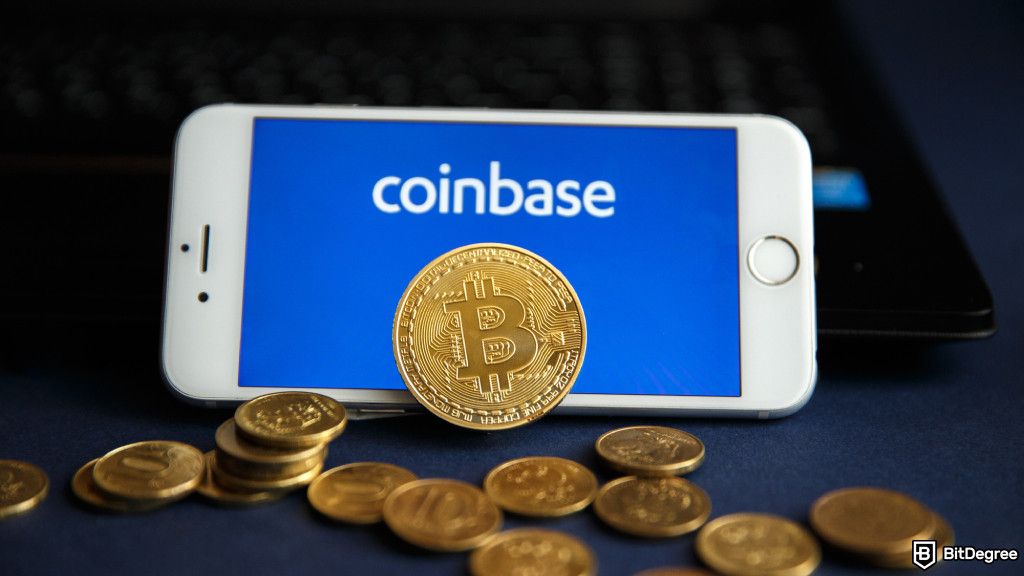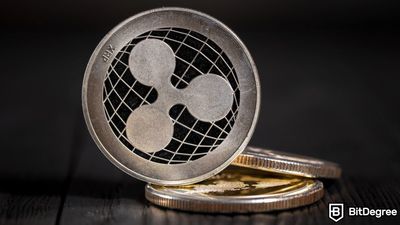Key Takeaways
- The fees vary depending on the funding method and the type of asset you're transferring;
- Coinbase withdrawal fees for fiat range from free to $25, while the costs for crypto depend on the specific asset being withdrawn;
- The trading fees operate on a maker-taker model, where regular spot rates for makers start at 0.60% and takers at 1.20%.
Free Airdrop Season 7 is LIVE! Answer fun questions or do simple tasks to earn rewards from the $30K BitDegree prize pool. Participate Now ! 🔥
If you’re on the lookout for a reliable crypto exchange to make your first trade, chances are you’ve heard of Coinbase already. You might be eager to try it out, but you want a clear picture of Coinbase fees first, and that’s totally fair!
Along with other popular names like Binance and Bybit, many consider Coinbase to be a solid choice for beginners, thanks to its intuitive design, user-friendly features, and competitive fees. But what are Coinbase fees exactly when it comes to sending or withdrawing crypto? Are there hidden costs? And is there a way to avoid Coinbase fees altogether?

Did you know?
Subscribe - We publish new crypto explainer videos every week!
What is Olympus DAO? (OHM Crypto Animated Explainer)


Table of Contents
- 1. Coinbase Fees
- 1.1. Deposit Fees
- 1.2. Withdrawal Fees
- 1.3. Trading Fees
- 1.4. Other Coinbase Fees
- 2. Coinbase Fees Comparison
- 2.1. Coinbase Fees VS Bybit Fees
- 2.2. Coinbase Fees VS Binance Fees
- 3. How to Reduce Coinbase Fees: Tips and Tricks
- 3.1. Subscribing to Coinbase One
- 3.2. Progressing Through Coinbase Fee Tiers
- 3.3. Adjusting Network Fees
- 3.4. Making the Most of the Referral Program
- 4. Conclusions
Coinbase Fees
If this is your first time in the crypto market, the first question on your mind might be, “Does Coinbase charge fees for its services?” Well,—yes. Just like any other exchange, transaction costs are very much a part of the experience.
Latest Deal Active Right Now:Head to BitDegree Missions, gather as many Bits as possible & claim your stake of the $30,000 Prize Pool! Don't waste your time & start collecting Bits by completing Missions and referring friends.
These fees are in place to keep the platform secure, reliable, and user-friendly. They cover the technology, security measures, and customer support that keep things running so you can enjoy a safe and accessible experience.
Coinbase offers a wide variety of services, and with that comes various fees. The number you’ll pay depends on what you’re doing. Want to buy, sell, or transfer crypto? There’s a fee for each of these, depending on the type of transaction or service you’re using.
Another thing to note before exploring Coinbase fees is that the platform requires all users to complete a verification process known as “Know Your Customer”. This process usually involves submitting a government-issued ID, like a driver’s license or national ID card, to protect against illegal activity and ensure safety for all[1].

With that in mind, let’s break down the different costs, starting with deposit and moving through other key expenses like Coinbase buy & sell fees. Keep in mind that these charges can change from time to time, so it’s a good idea to check the latest information on the platform’s pricing and fees page.
Deposit Fees
Coinbase deposit fees can differ based on how you add your funds and what type of asset you’re transferring. For starters, if you’re sending in cryptocurrency, there’s usually no additional charge.
However, if you’re depositing crypto from an external wallet or another exchange to your Coinbase account, you’ll likely need to pay a transaction fee. This additional charge depends on the coin type, network congestion, and the specific network.
As of writing, Coinbase supports Ethereum, Solana, and all EVM-compatible networks via its mobile app and browser extension.

If you mistakenly send an asset that is unsupported by these networks, Coinbase offers a recovery service. This service charges a transition fee, and if the currency you’re trying to recover is over $100, there’s an additional 5%.
Note that the Coinbase fee for this recovery service might not match the value of the recovered asset, and there’s no guarantee of success. To prevent asset loss, be sure to verify the network details carefully before transferring.
As for adding regular money, Coinbase deposit fees may apply depending on the fiat currency and how you’re paying. Here’s a quick look at what those charges might be:
- ACH: Free deposits;
- Wire Transfer (USD): $10 deposit fee;
- SEPA (EUR): €0.15 deposit fee;
- SWIFT (GBP): Free deposits.
The platform also offers an on-ramping service that lets you deposit crypto instantly by converting fiat currency. Coinbase buying fees for purchasing crypto with fiat can vary based on factors like spread, network fees, payment method, order size, and market conditions.
That said, you can see the clear breakdown of these fees before confirming a transaction, so you know exactly what you’ll be paying.
Developers can use the on-ramping service free of charge. And if you deposit with USDC, it comes with zero Coinbase transfer fees to your account.
Withdrawal Fees
After learning about deposit fees, you might also ask, “What are Coinbase fees for withdrawing to an external wallet or bank?”.
Like most exchanges, Coinbase withdrawal fees can differ based on the crypto assets in question and the network you use. Generally, faster and more efficient networks offer lower fees, while slower and more popular networks might cost a bit more[2].
Each cryptocurrency also has set minimum and maximum withdrawal limits. So, it’s worth the official website for the latest details on limits for each coin on top of Coinbase transfer fees that might change.
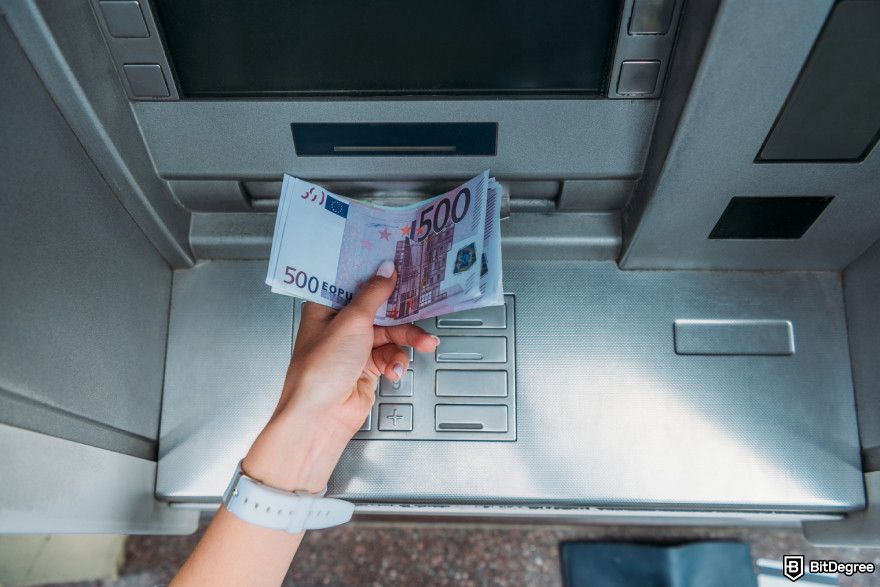
For instance, if you want to withdraw Bitcoin, the minimum amount is 0.0001 BTC, and the maximum is 2,400 BTC. Ethereum minimum is also 0.0001 ETH, with a maximum of 40,000 ETH.
If you’re withdrawing regular money from Coinbase to your bank account, fees may also apply depending on the currency and withdrawal method. Here’s a quick overview of Coinbase withdrawal fees for fiat currency:
- ACH: Free;
- Wire Transfer (USD): $25 per withdrawal;
- SEPA (EUR): Free;
- SWIFT (GBP): £1 per withdrawal.
As for how much money you can withdraw, most users start with a limit of $100,000 per day. However, this can vary depending on your account’s verification level and the withdrawal method.
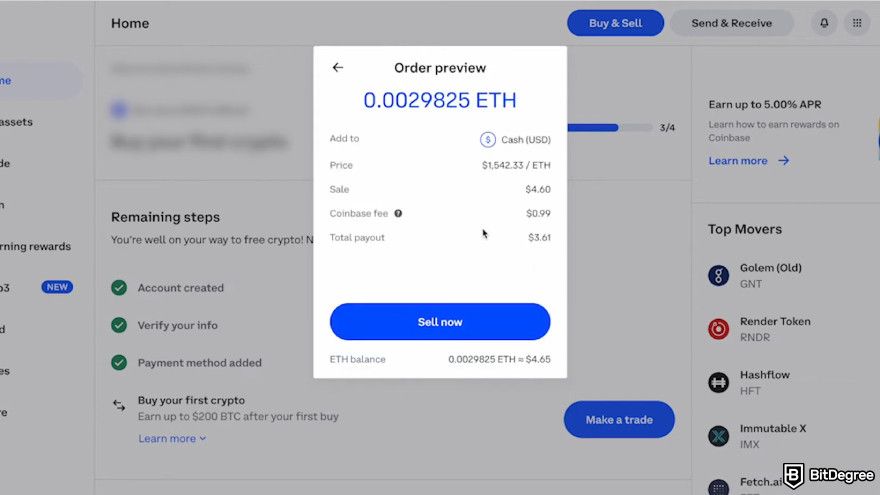
By familiarizing yourself with the withdrawal costs and limits, you’ll be in a much better position to manage your holdings wisely. Once you’re comfortable with that, you’ll be ready to explore the ins and outs of Coinbase trading fees.
Trading Fees
As mentioned earlier, Coinbase fees are structured to suit all kinds of traders. It doesn't matter whether you’re a beginner just learning the ropes or a professional trader dealing with bigger transactions.
The pricing system, known as Coinbase Advanced trading fees, is similar to most trading platforms. The charges depend on your tier when you place an order, not on your tier after the trade completes.
This structure helps keep fee calculations predictable, especially for high-frequency traders who depend on knowing their costs upfront.
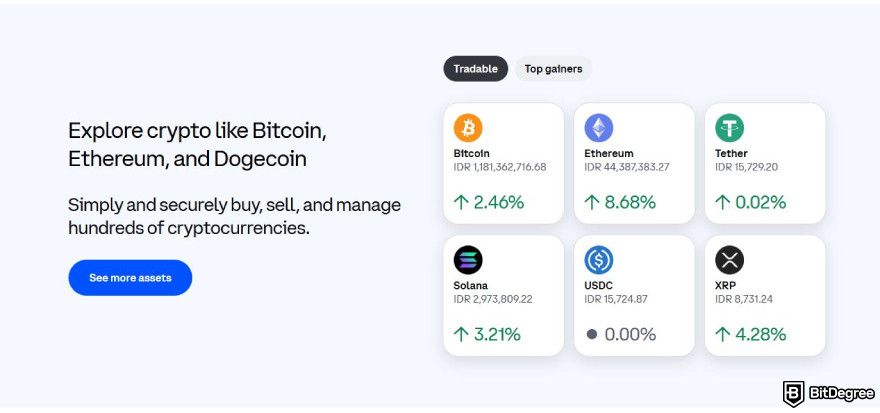
Coinbase trading fees also vary based on your role as a maker or a taker. Makers place orders that aren’t immediately filled, allowing other traders to buy or sell against them. On the other hand, takers complete trades right away by accepting existing orders on the platform.
Like many exchanges, Coinbase's maker-taker fee structure charges takers higher rates than makers, as makers help add liquidity to the market.
With that in mind, let’s take a closer look at the prices for each type of transaction, including spot and futures trading fees.
Spot Fees
Coinbase spot fees vary depending on your 30-day trading volume, your asset balance, and whether you’re a maker or taker. For those trading under $1,000 monthly, the rates start at 0.60% for makers and 1.20% for takers.
To reach the first Advanced trading fees tier, you’ll need to trade over $10,000 in a month or maintain a $1M asset balance. By doing so, you’ll enjoy a maker-taker fee reduction of 0.25% and 0.40%, respectively.
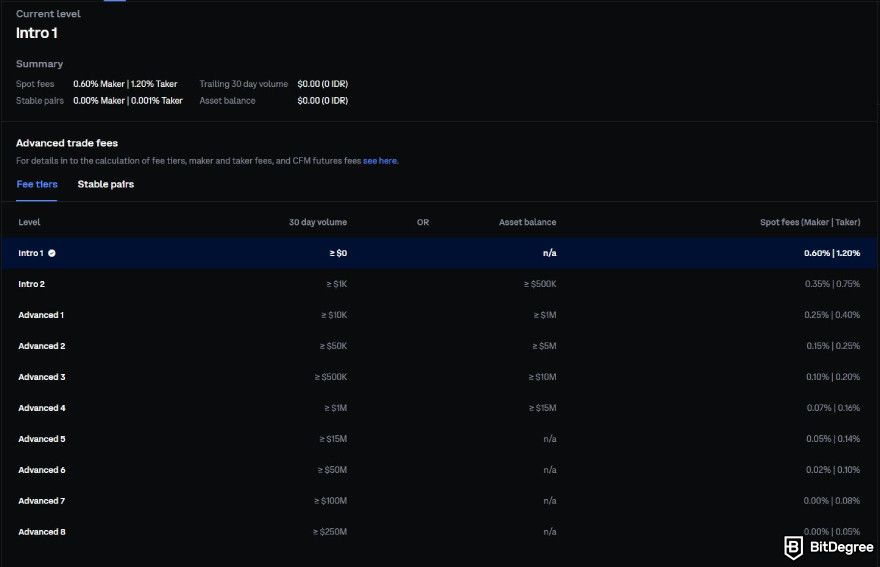
As your transaction volume increases, your Coinbase day trading fees will also decrease. For those trading over $250 million within a 30-day period, costs can go as low as 0.05% for takers and 0.00% for makers.
For trading stable pairs like USDT/EUR or WBTC/BTC, the maker rate starts at 0.00%, and the taker ranges from 0.10% to 0.45% based on your Coinbase Advance trading fee level.
Futures Fees
Coinbase futures fees apply to both opening and closing positions for each trade, with a minimum payment of $0.20 per transaction. Like spot trades, the rates follow the Coinbase Advanced fee schedule, so the more you trade, the lower your fees as you climb through the tiers.
To help you manage the risk, Coinbase offers two margin options: cross margin and isolated margin.
Cross margin uses your entire portfolio as collateral for all open positions, while isolated margin limits risk to individual trades. This way, you have better control over potential losses and added peace of mind.
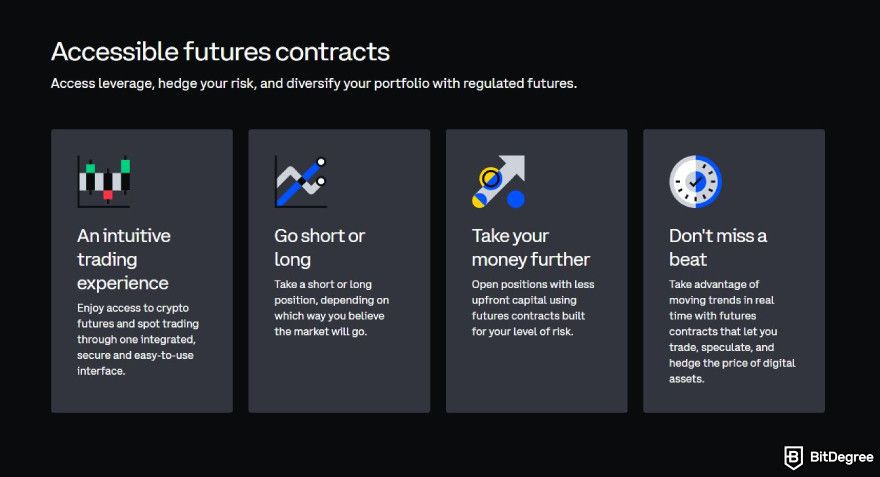
Aside from Coinbase futures fees, be aware of a 0.80% charge per transaction if your position gets liquidated—something to keep in mind before diving in.
Other Coinbase Fees
If you plan to explore everything the exchange offers, you may encounter a few additional Coinbase fees in addition to the regular trading, deposit, and withdrawal costs. These extra charges appear with features like staking, NFT transactions, the Coinbase Card, or the Coinbase One subscription service.
Also, you might come across what feels like Coinbase hidden fees—charges that aren’t always immediately obvious. Let’s break down these additional payments, so you know what to expect and can avoid any surprises while using the platform.
Coinbase Staking Fees
You might come across the earning feature and wonder, “Does Coinbase charge fees for staking?”.
While it costs nothing to stake or unstake, your rewards are still subject to Coinbase staking fees. This means that as your staked assets grow, the platform takes a percentage from your earned rewards as a service fee for managing the process.

For coins like ADA, ATOM, DOT, SOL, and XTZ, the standard staking rate is 35%. And if you’re subscribed to Coinbase One, you’ll enjoy a reduced fee of 26.3%.
Note that this Coinbase staking fee is automatically deducted from your rewards. So, the APY displayed on your Earn page reflects your actual earnings after the cut. This way, you'll know precisely what to expect in net returns after the service charge.
Coinbase NFT Fees
To buy NFTs on Coinbase, you’ll need a safe crypto wallet, such as a Ledger Nano X or Trezor Safe 5. Then, you’ll need to link it to your Coinbase account and make sure it has some Ethereum in it.

While Coinbase doesn’t charge extra fees for buying NFT, there are costs associated with processing your transaction. So, it’s a good idea to have some extra Ethereum in your wallet to cover these additional charges.
Coinbase Card Fees
If you’re planning to use the Coinbase Card for everyday crypto spending, you’ll be happy to know the platform won’t charge you with transaction costs. That said, standard Coinbase fees with a small spread will apply when you convert crypto to USD for a purchase.

Coinbase also doesn’t impose any extra charges for ATM withdrawals. However, be aware that some ATM operators might have their own fees. So, it’s a good idea to check the cost information at each ATM before withdrawing funds.
Coinbase One Fees
Coinbase One is a subscription service that costs $29.99 per month. If you have a discount code, you can use it at checkout to lower this fee.
By subscribing, you can enjoy various perks, including zero Coinbase transaction fees, rebates on advanced trades, and exclusive customer support. It’s an appealing option for anyone who wants to save on cost, especially if you’re a frequent trader.
Coinbase Hidden Fees
After taking a closer look at the Coinbase fee schedule, I’d say the exchange does a pretty good job of keeping things transparent. There are plenty of support pages that break down the different costs you might run into while interacting with its various services.

That said, some payments might not be obvious at first glance and can feel like “Coinbase hidden fees”, especially if you’re new to the platform. To help you avoid surprises, here’s a quick overview of what to watch for:
- Gas Fees: If you’re transferring crypto, you’ll likely encounter gas fees. These aren’t Coinbase hidden fees; they’re charges from the blockchain for processing your transaction. Coinbase provides an estimate, but the actual cost depends on network congestion and can fluctuate;
- Spread Fees: When you buy or sell crypto, a spread fee—a small price difference—locks in the rate while you review transaction details. This charge isn’t fixed and can be easily overlooked, but don’t worry! You’ll see the final Coinbase buy & sell fees clearly on the order preview page;
- Coinbase One Trading Fees: Many people assume that subscribing to Coinbase One means zero Coinbase fees on all trades, but that’s not entirely the case. The zero-fee benefit only applies to “simple” trades. For advanced trading, the regular tiered fee structure still applies.
These aren’t really “Coinbase hidden fees”, but they’re worth knowing so you can go in prepared. By being aware of these costs, you’ll have a better handle on what to expect when using the platform—and you’ll be much less likely to encounter surprise fees on your transactions.
Coinbase Fees Comparison
Now that you’ve got a detailed look at the Coinbase fee schedule, you might be curious how it stacks up against other popular exchanges out there. Knowing these differences can help you decide if Coinbase buying fees and selling prices fit your style and budget.
Here, I’ll break down trading, deposit, and withdrawal fees alongside those of two other major platforms: Bybit and Binance.

Did you know?
Subscribe - We publish new crypto explainer videos every week!
Blockchain Transaction Easily Explained! (Animated)


Coinbase Fees VS Bybit Fees
When it comes to trading costs, Coinbase and Bybit share a similar tiered structure where charges decrease as your trading volume increases. However, they differ significantly in how these levels are reached and the maximum fee reductions each platform offers.
With Bybit, moving up the VIP tiers can be a bit steeper—you need to trade at least $1,000,000 over 30 days to qualify for the first tier (VIP 1). Once you reach this level, your spot fees become 0.0675% for makers and 0.0800% for takers.
In contrast, to reduce Coinbase maker-taker fees to 0.2500% and 0.4000%, you need to reach the first tier by having $10,000 trading volume in a month.
At the highest levels, Bybit fees can fall as low as 0.0050% for makers and 0.0150% for takers. However, Coinbase offers a zero-fee rate for makers at its top tier, which may be especially appealing to those placing frequent, large orders.
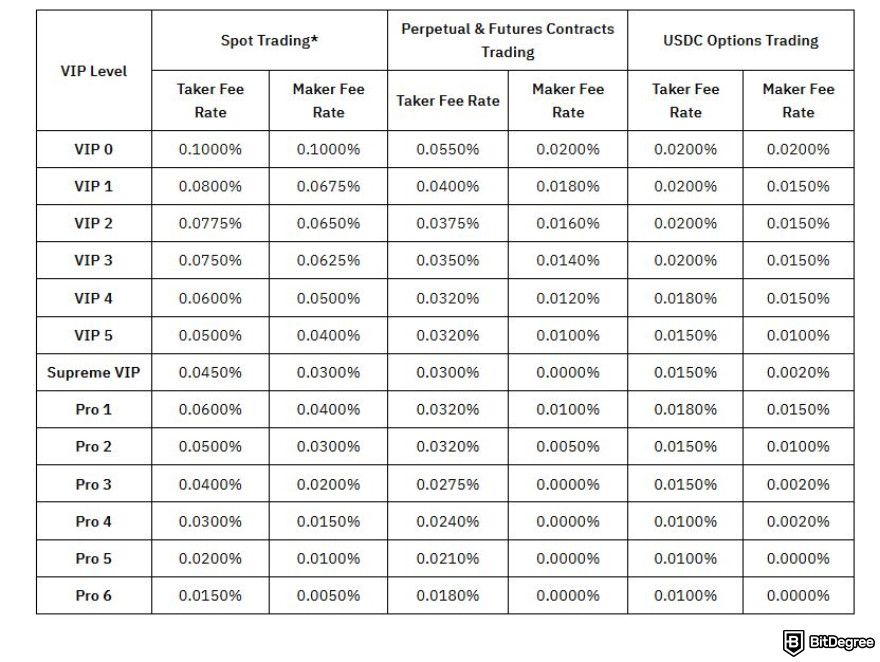
For short-term traders and speculators, Coinbase day trading fees might seem preferable at first. The zero maker charges at the highest level allow active traders to place and cancel orders without incurring costs, which can be particularly useful in high-frequency trading.
Still, Bybit has a lower top-tier taker fee. If you’re a trader who relies more on market orders, Bybit’s lower taker rate may offer better savings.
Now, if you’re a more casual trader and prefer not to focus on progressing through the tiers, Bybit has lower starting fees at 0.10% for both makers and takers. These are more favorable than Coinbase regular fees of 0.60% for makers and 1.20% for takers.
As for depositing money, both platforms usually let you deposit cryptocurrencies for free. However, if you’re depositing fiat, the fees can change based on the payment method. The costs for withdrawing your assets also vary depending on the type of cryptocurrency or fiat currency you choose.

All in all, both platforms reward higher trading volumes with reduced rates. For high-frequency traders, Coinbase day trading fees might offer a better advantage with its zero maker fees at the top tier, though its taker fees remain higher than Bybit’s.
Coinbase Fees VS Binance Fees
Coinbase and Binance are among the top popular exchanges in the market for trading digital assets. Although both feature a tiered fee structure that reduces rates as trading volume increases, they differ in their starting charges and the perks available at higher levels.
Binance starts with a lower entry rate for regular users, with a 0.1000% maker-taker fee for spot trading—significantly lower than Coinbase’s starting rate.
However, the requirements for moving up the tier structure can be a bit demanding. To reach the first VIP level, you need to have a minimum monthly trading volume of $1,000,000 and 25 BNB tokens. At the highest tier, the rates drop to 0.011% for makers and 0.023% for takers, with an additional 25% discount when paying with Binance coins.
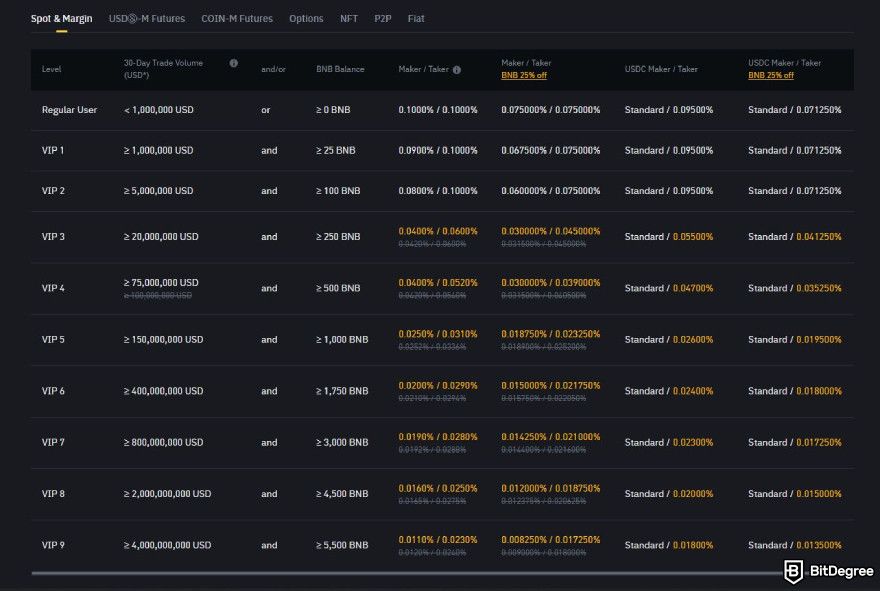
Both exchanges also offer free cryptocurrency deposits, but fees for fiat deposits vary by payment method. Withdrawal rates also differ depending on whether you’re withdrawing crypto or fiat currency.
In short, Binance’s lower starting fees and BNB discounts can be more appealing if you’re just starting out or a casual trader. However, the Coinbase day trading fee schedule offers zero maker rate at its highest tier, which may be more attractive for professionals who frequently use limit orders.
How to Reduce Coinbase Fees: Tips and Tricks
Knowing about all these costs you have to pay, you might start to wonder how to avoid Coinbase fees altogether. I get it—who wouldn’t want to trade without these pesky charges eating into your hard-earned profits?
But, sadly, there’s no such thing as a free lunch in this world. Coinbase fees are here to stay, and dodging them completely would mean stepping outside the rules and regulations (which isn’t exactly advisable). Besides, those additional charges aren’t just there to annoy you; they actually help keep the exchange and blockchain secure.
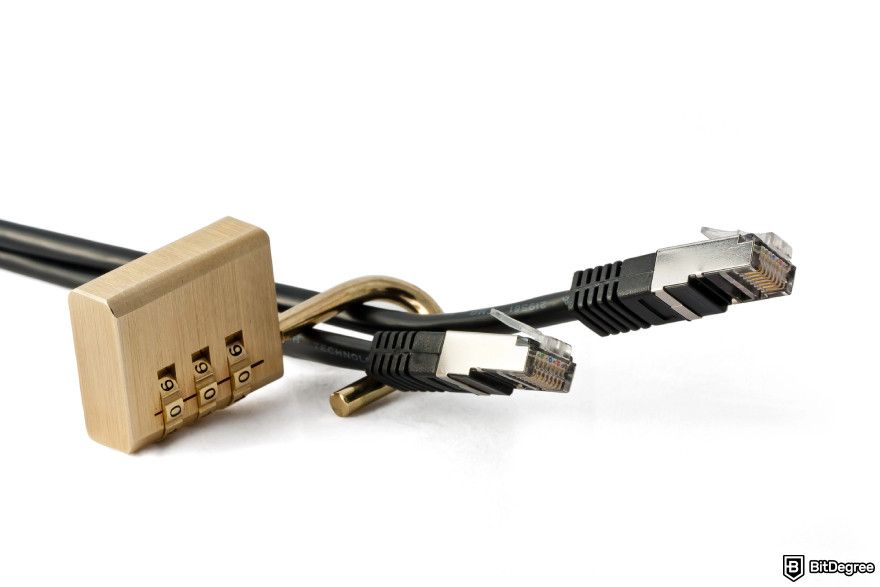
While there’s no magic trick to make them disappear, you can reduce Coinbase fees and save more of your money with a few smart approaches.
Subscribing to Coinbase One
If you’re looking to cut down on costs, subscribing to Coinbase One is worth considering. This monthly membership program packs some nice perks that make trading a lot more wallet-friendly. For $29.99 a month, you can enjoy the following benefits:
- Zero-Fee Simple Trades: If you’re making regular trades, this perk can be a game-changer—say goodbye to fees chipping away at your gains;
- Rebates on Coinbase Advanced Trading Fees: You can enjoy up to 25% rebate on advanced spot fees, credited back to your account in USDC;
- Boosted Rewards: If you hold USDC, Coinbase One can increase your rewards, helping you grow your balance faster;
- Account Protection: Gain some extra peace of mind with protection of up to $250,000 against unauthorized access to your account.
Looking at these perks, it’s safe to say that the monthly subscription is worth it, especially if you’re a frequent trader. And if you’re still wondering how to trade on Coinbase without fees, this is one of the few legit ways to do it—well, at least for the simple trades.
Progressing Through Coinbase Fee Tiers
Although it may not be the most beginner-friendly method, scaling up the tier structure is one of the most effective ways to reduce Coinbase fees.
The platform’s tiered schedule rewards users who trade frequently. If you achieve specific trading levels within a month, you will automatically advance to a tier with lower fees.
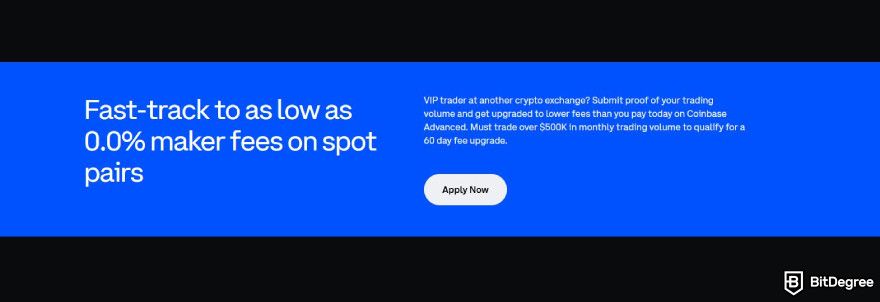
At the highest tiers, the maker fee can drop to 0.0%, a significant reduction from the initial rate of 0.6%. You can easily check the fee section in your Coinbase account to view your current tier and track your progress.
Climbing to higher levels does require a significant trading volume. Still, it’s an effective approach to reduce Coinbase fees if you’re already trading often and looking to maximize savings over time.
Adjusting Network Fees
Another way to save on Coinbase transaction fees is by manually adjusting the network cost—a handy trick, though it may require some patience.
When you adjust the network rates in Coinbase, you can select a speed that affects how quickly your transaction gets confirmed. Opting for a slower speed usually means lower charges, which is also a great option if you want to cut Coinbase buy-sell fees. Here’s how to do it:
Step 1: Log in to your Coinbase account and start your transaction as usual.
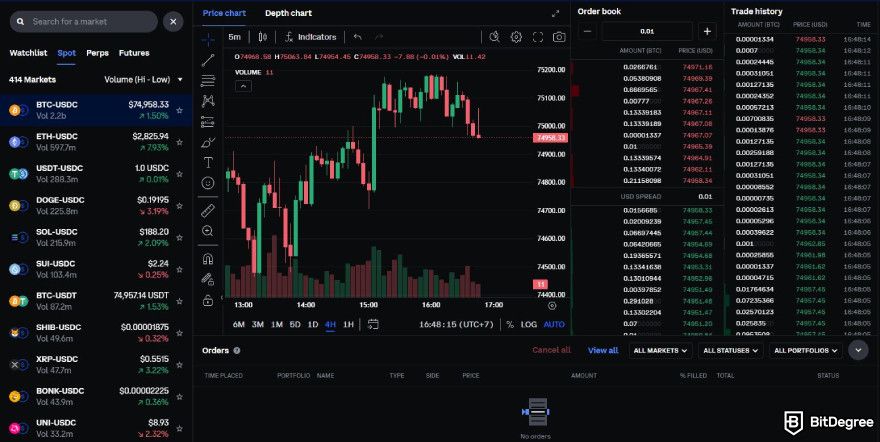
Step 2: Tap on the network fee amount displayed on the screen.
Step 3: Change your speed to “Slow”, or choose “Custom” if you want to manually set the max fee, priority fee, or gas limit for more precise control.
Adjusting the network speed may not be the most effective route, but it’s a neat option to have if you’re trading on a budget and can spare a bit of time.

- Secure and reliable
- Accepts fiat currencies
- Lots of trading options
- Reputable exchange
- Accepts fiat currencies
- Offers various trading options

- Fiat currencies - accepted
- Simple to use
- Accepts only the most trustworthy cryptocurrencies
- A leading cryptocurrency exchange platform
- Best for beginner investors
- Accepts fiat currencies

- Fully reserved and transparent
- Multiple tradable asset classes
- Over 300 supported cryptos
- Over 300 cryptocurrencies
- Secure & transparent
- Fully reserved
Making the Most of the Referral Program
Another method to reduce your Coinbase fees is by taking advantage of the platform’s referral program.
When you invite a friend to trade on Coinbase, you can earn a portion of their transaction fees as a referral bonus. While this doesn’t directly reduce your own rates, the rewards can go a long way in balancing out what you’re paying.

To get started, simply share your referral link with friends who are interested in trading cryptocurrencies. If they try out Coinbase Advanced and haven’t traded there in the last year, you’ll earn 30% of the fees they pay. The more they trade, the more you benefit—without putting in much extra effort.
So, while these methods might not show you how to trade on Coinbase without fees entirely, they can certainly help you save some money. If you’re just making a few small trades, you might not see a huge difference right away. But as you trade more, those savings can really start to add up and make a positive impact on your bottom line!
Conclusions
In wrapping up, understanding Coinbase fees and how to manage them can make a real difference in your trading experience. The platform has a specific tiered structure that charges you lower as your monthly trading volume increases. This system offers flexibility for both beginners and professional traders.
Other well-known exchanges, like Bybit and Binance, also provide similar tiered schedules with variations in the trading volume needed to reach higher levels and specific fees at each tier. Even when compared to these platforms, Coinbase maker-taker fees are still quite competitive, especially for those who trade frequently and want to keep their costs low.
The content published on this website is not aimed to give any kind of financial, investment, trading, or any other form of advice. BitDegree.org does not endorse or suggest you to buy, sell or hold any kind of cryptocurrency. Before making financial investment decisions, do consult your financial advisor.
Scientific References
1. S. Fugkeaw: 'Enabling trust and privacy-preserving e-kyc system using blockchain';
2. G. Shang, N. Ilk, S. Fan: 'Need for speed, but how much does it cost? Unpacking the fee-speed relationship in Bitcoin transactions'.

